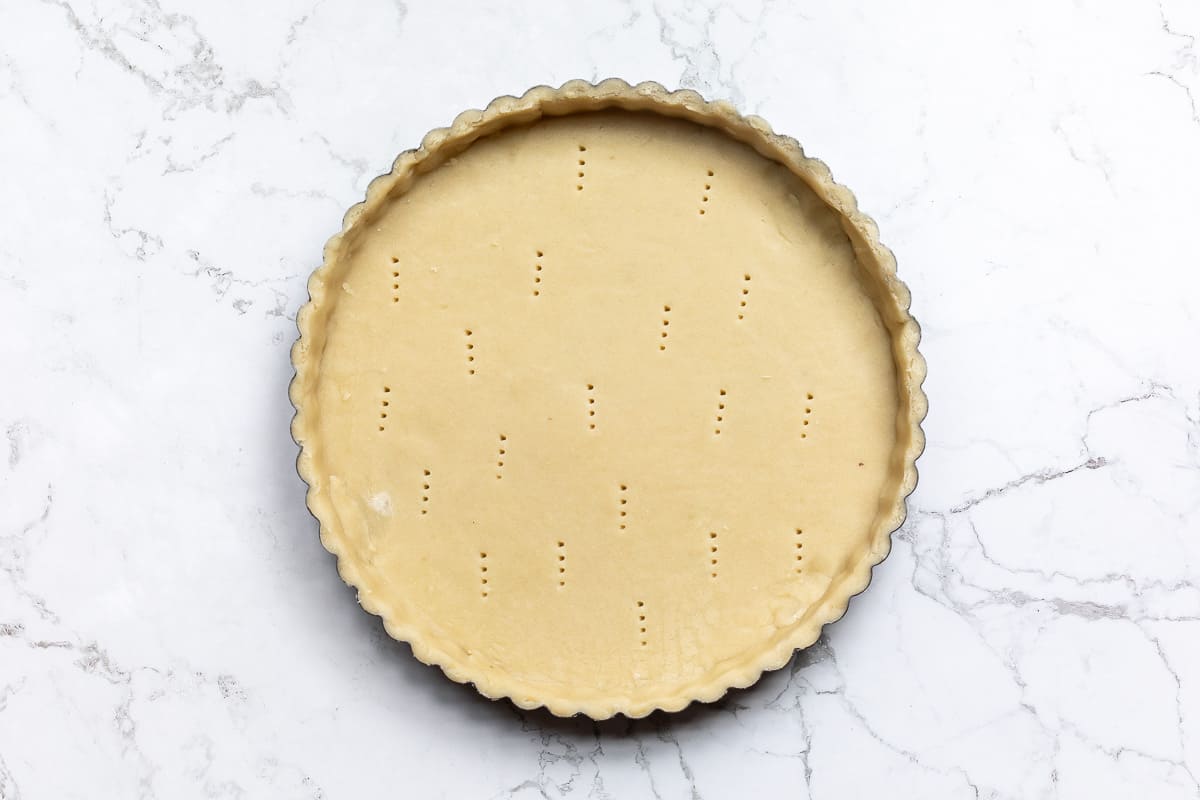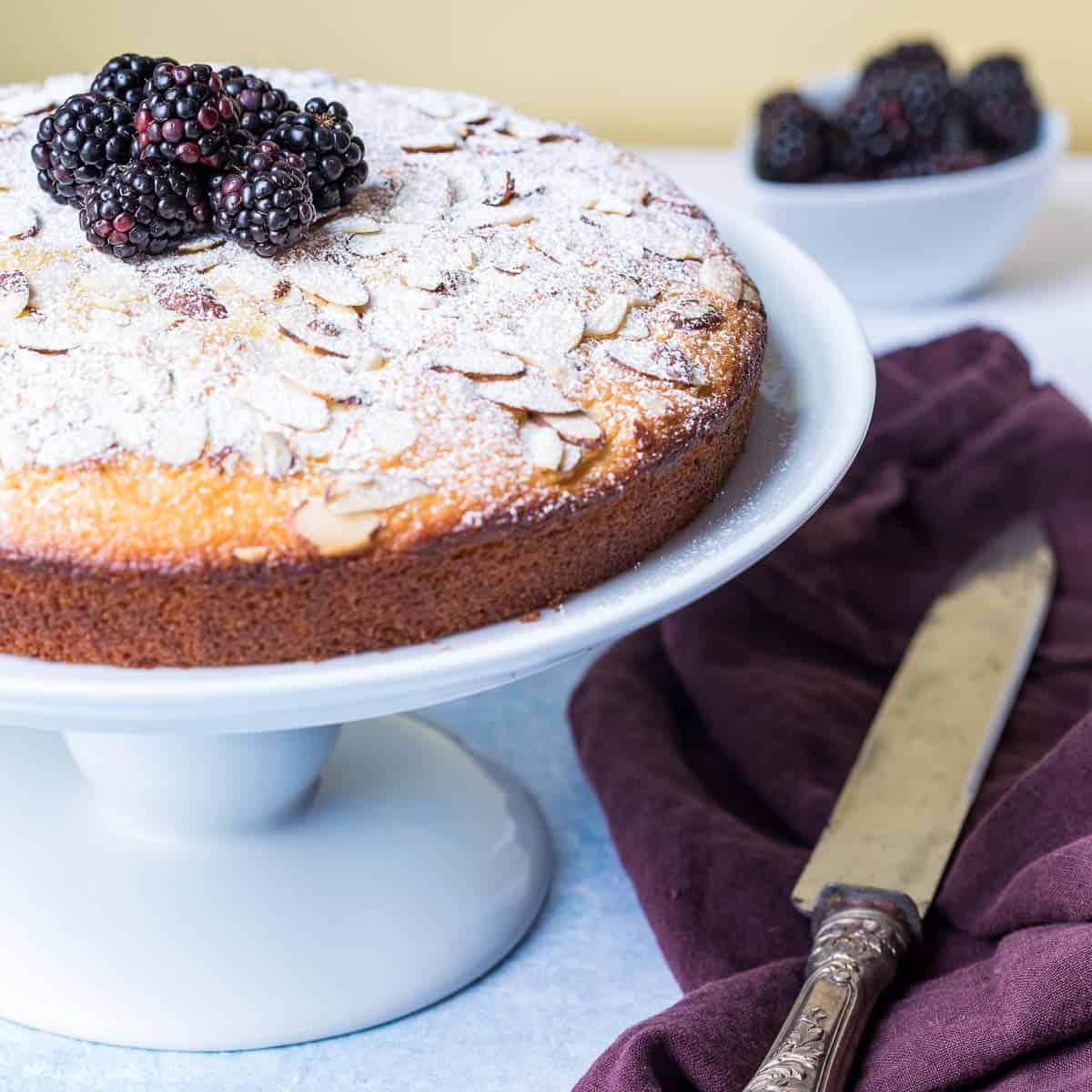This Pâte Sucrée is a sweet, shortcrust pastry dough with the snappy texture of a shortbread cookie. Makes a sturdy base for fruit tarts and other tarts with unbaked fillings.

This recipe was one of the building-block crusts I learned in pastry school. Along with Pâte Sablée, it’s a classic for French tarts like this Tarte aux Fraises. It’s an enriched dough, since an egg is used in the ingredients. My version also includes almond flour, which adds just the slightest nutty flavor to the dough.
Jump to:
Why Make This Recipe
- Classic French tart dough
- Strong and sturdy when baked, so it holds up well to custard fillings and does not become soggy
- Sweet and lightly nutty, like eating a shortbread cookie at the bottom of your tart!
🥗 Ingredients

- Butter: Use salted or unsalted, whichever you prefer.
- Powdered Sugar: Using confectioner’s sugar helps create a smooth dough and contributes to the final crust texture. If you don’t have powdered sugar, blitz regular granulated sugar in a blender or food processor, and it becomes powdered sugar!
- Almond Flour: You can use either almond flour or almond meal for this recipe, but almond flour will give you a smoother texture.
- Egg: This recipe does require an egg, as pâte sucrée is an enriched dough.
- Flour: All-purpose flour works just fine for this recipe.
🥣 Step-by-Step Instructions
Using a stand mixer with the paddle attachment, beat 12 tablespoons softened butter, ¾ cup powdered sugar, ¼ cup almond flour, and a pinch of kosher salt until well-combined.

Beat in 1 egg until smooth, scraping down bottom and sides as necessary. Add 2 ⅓ cups flour and mix just until dough comes together.

Split dough in half, and form each half into a disk. Wrap each disk in plastic wrap and chill until firm. (At least 1 hour, and up to 3 days).

To bake, preheat oven to 350 degrees. Remove dough from refrigerator and let warm up on the counter for about 10 minutes (if it has been chilled for several hours). Put the disk of dough on a floured sheet of parchment paper, then cover with a second sheet.

Roll out dough into an 11-inch circle. If dough cracks and breaks while you are rolling it, wait until it has warmed up a bit more. Once dough is rolled out, return to the refrigerator for 5 minutes. Peel off the top sheet of parchment paper.

Now flip the dough over a 9-inch nonstick tart pan with a removable bottom. Peel off the bottom sheet of parchment (now on the top) and press dough gently but firmly into the bottom and sides of the pan.

Trim excess dough around the sides, and press the dough over the top of the tart shell cutting the excess off with your thumb and making a smooth edge that goes right up to the top of the pan. Prick the bottom of the crust with a fork.

Put back in the refrigerator for 10 minutes.
Cover dough with parchment paper, then baking weights, beans, or rice. Place tart pan on a baking sheet.

Bake until edges are golden, about 20 minutes. Remove parchment paper and beans. The bottom of the crust will look pale and may have some small spots that look a bit raw still.
If you are just par-baking the crust, you're done and ready to move on with the recipe for your filling.
To fully bake your pâte sucrée crust, put it back in the oven and bake until crust is totally dry on the bottom and golden brown, about 10-15 minutes. Cool on rack before filling.

🧐 Recipe FAQs for Pâte Sucrée
If you did not chill your crust before baking, that could be the cause of the cracking. In addition, the pastry crust will crack in the oven if the dough was rolled out too thin. The good news is that you can just cover with pastry cream or whatever filling you are using, and no one is likely to see!
This shortbread crust recipe is perfect for tarts with unbaked fillings, because it is plenty sturdy once baked. It’s delicious as a base for Tarte aux Fraises or really any French fruit tart. It’s lovely with a no-bake cream cheese filling or lemon curd filling as well.
Sucrée means sweet in French, and sablée means sandy. Pâte sucrée is generally sweeter than pâte sablée and makes a crisp tart crust in compared to the more crumbly pâte sablée. There is also a third basic French tart dough called a pâte brisée that is not sweetened and generally used for savory tarts.
Par-baking is when you bake the tart crust halfway, then fill the tart and continue baking until tart and crust are fully done. This is often done with tarts and quiches that have liquid fillings that must be cooked.
👩🍳 Expert Tips
This pâte sucrée recipe makes two 9-inch crusts. If you don’t need both at one time, put the extra dough into the freezer for up to 3 months.
This sweet pastry dough is very soft, which is the reason we recommend chilling after rolling and before putting in tart shell. If it is too soft when you try to line your tart pan with it, it will break. On the other hand, it will also break if it is too cold! So just a few minutes in the fridge to firm it up, then line your pan with it. The good news is that this dough is very forgiving. Just patch it if it breaks, and smooth the patch into the rest of the dough.
You can also set yourself up for success with this dough by using a good-quality rolling pin. A marble surface can also be useful as it helps the dough stay cool when rolling rather than warming up quickly.
The reason this shortcrust needs to chill before baking is that chilling lets the butter firm up so the hot oven doesn’t melt it too quickly and cause dough to shrink. The chilling/resting also lets the gluten relax which also reduces shrinking in the pan.
The only downside of this crust in our opinion is that it is hard to slice because it is so sturdy. If you want to avoid having to slice it to serve, we highly recommend using this recipe to make mini tartlets.

Other French Pastries
Love French desserts as much as we do? Why not check out some of our other favorite recipes:
If you try this Pâte Sucrée recipe, we would love to hear from you! Please rate this recipe and leave a comment below—your feedback is invaluable to us.
And please follow along on Instagram, Pinterest, and Facebook or subscribe to our newsletter. We’d love to inspire you with more delicious, healthy, and seasonal recipes!
Want to Save This Recipe?
Enter your email & I'll send it to your inbox. Plus, get great new recipes from me every week!
By submitting this form, you consent to receive emails from Vanilla Bean Cuisine.
📖 Recipe

Pâte Sucrée
This Pâte Sucrée is a sweet, shortcrust pastry dough with the snappy texture of a shortbread cookie.
Ingredients
- 12 tablespoons butter, slightly softened
- ¾ cup powdered sugar (3.2 ounces)
- ¼ cup almond flour (1 ounce)
- Pinch kosher salt
- 1 egg
- 2 ⅓ cups all-purpose flour (12.6 ounces)
Instructions
- Using a stand mixer with the paddle attachment, beat the butter, sugar, almond flour, and salt until well-combined.
- Beat in egg until smooth, scraping down bottom and sides as necessary.
- Add flour and mix just until dough comes together.
- Split dough in half, and form each half into a disk.
- Wrap each disk in plastic wrap and chill until firm. (At least 1 hour, and up to 3 days).
- To bake, preheat oven to 350 degrees.
- Remove dough from refrigerator and let warm up on the counter for 10 minutes.
- Put the disk of dough on a floured sheet of parchment paper, then cover with a second sheet.
- Roll out dough into an 11-inch circle. If dough cracks and breaks while you are rolling it, wait until it has warmed up a bit more.
- Once dough is rolled out, return to the refrigerator for 5 minutes.
- Peel off the top sheet of parchment paper and flip the dough over a 9-inch tart pan with a removable bottom.
- Peel off the bottom sheet of parchment (now on the top) and press dough gently but firmly into the bottom and sides of the pan.
- Trim excess dough around the sides, and press the dough over the top of the tart shell cutting the excess off with your thumb and making a smooth edge that goes right up to the top of the pan.
- Prick the bottom of the crust with a fork.
- Put back in the refrigerator for 10 minutes.
- Cover dough with parchment paper, then baking weights, beans, or rice.
- Place tart pan on a baking sheet. Bake until edges are golden, about 20 minutes.
- Remove parchment paper and beans.
- If tart shell needs to be fully baked for your recipe, put back in the oven and bake until crust is totally dry and golden brown, about 10-15 minutes.
- Cool on rack before filling.
Notes
Storage Tips:
Baked tart shell can be wrapped with plastic wrap or foil. It can be kept at room temperature for 2-3 days.
Expert Tips:
This pâte sucrée recipe makes two 9-inch crusts. If you don’t need both at one time, put the extra dough into the freezer for up to 3 months.
This sweet pastry dough is very soft, which is the reason we recommend chilling after rolling and before putting in tart shell. If it is too soft when you try to line your tart pan with it, it will break. On the other hand, it will also break if it is too cold! So just a few minutes in the fridge to firm it up, then line your pan with it. The good news is that this dough is very forgiving. Just patch it if it breaks, and smooth the patch into the rest of the dough.
The reason this shortcrust needs to chill before baking is that chilling lets the butter firm up so the hot oven doesn’t melt it too quickly and cause dough to shrink. The chilling/resting also lets the gluten relax which also reduces shrinking in the pan.
This crust is particularly great for mini tartlets, as it is sturdy and somewhat hard to slice in its larger format.
Recommended Products
As an Amazon Associate and member of other affiliate programs, I earn from qualifying purchases.
-
DATANYA 8 Pack Mini Tart Pans 4 Inch with Removable Bottom Round Nonstick Quiche Pan, Heavy Duty Fluted Side for Pies, Mousse Cakes, Dessert Baking (4 Inch 8pcs)
-
Farberware Classic Wood Rolling Pin, 17.75-Inch, Natural
-
Wilton Excelle Elite Non-Stick Tart and Quiche Pan with Removable Bottom, 9-Inch -
Nutrition Information:
Yield: 8 Serving Size: 1Amount Per Serving: Calories: 389Total Fat: 20gSaturated Fat: 11gTrans Fat: 1gUnsaturated Fat: 7gCholesterol: 69mgSodium: 157mgCarbohydrates: 46gFiber: 2gSugar: 11gProtein: 6g
Nutrition information is provided as a general reference for users courtesy of the online nutrition calculator Nutritionix.
Instagram Users: Now that you've made this sweet pastry dough recipe, tag us @vanillabeancuisine or #vanillabeancuisine because we’d love to see your results!










Leave a Reply